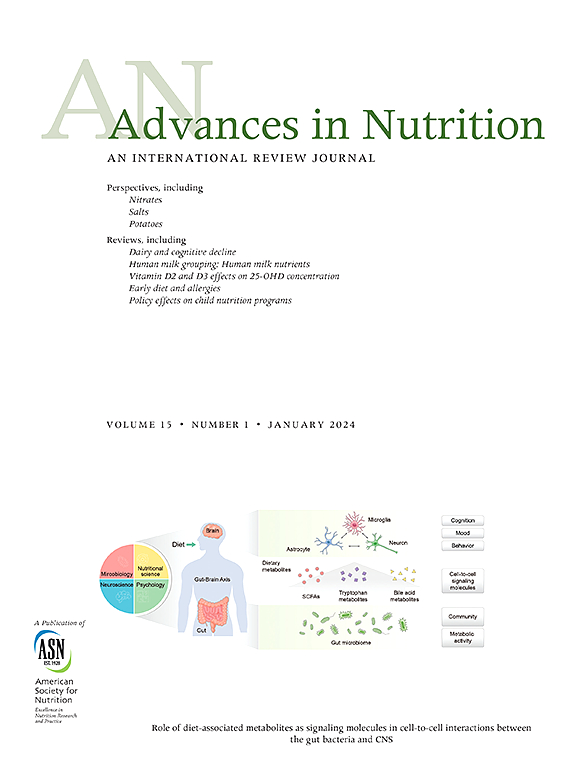Protein and Free Amino Acid Composition of Preterm Human Milk: A Systematic Review and Meta-analysis
IF 9.2
1区 医学
Q1 NUTRITION & DIETETICS
引用次数: 0
Abstract
The composition of total protein and free amino acids (FAA) in preterm human milk (HM) is crucial for optimizing infant growth and development. The objective of this systematic review and meta-analysis is to quantify the amount of true, crude, and unspecified protein and FAA in preterm HM. EBSCO, PubMed, and Scopus databases were searched up to July 2023 measuring total protein and FAA in preterm HM. Two reviewers, working independently, screened all titles and abstracts using Covidence software to identify studies meeting inclusion criteria [preterm <37 wk; Human Development Index >0.8; cross-sectional, case-controlled (n > 1), prospective cohort, and randomized clinical trials; English language]. Random-effects models were used to estimate mean protein and FAA content across studies. Data were aggregated for studies reporting multiple estimates (e.g. across time). Heterogeneity was estimated using I2 and publication bias using Kendall tau rank correlation coefficient. Of the 884 articles identified, a total of 66 original studies were included for the meta-analysis comprising an estimated 30,421 preterm HM samples. Preterm colostrum (<4 d) contained the highest mean (95% confidence interval) true protein at 2. 32 (1. 96, 2. 68) g/100 mL, followed by transition preterm HM (5–14 d) mean true protein of 1. 77 (1. 60, 1.93) g/100 mL. Mature (>14 d) preterm HM had the lowest mean true protein content at 1.46 (1.34, 1.59) g/100 mL. Glutamate was the most prevalent FAA reported. This systematic review provides updated estimates of protein and FAA concentrations in preterm HM. There was significant variability in the quality of studies, completeness of the reported results, and analytical methodologies across studies.
This trial was registered at PROSPERO as CRD42023445191.
早产儿母乳中蛋白质和游离氨基酸的组成:一项系统综述和荟萃分析。
早产儿乳汁中总蛋白和游离氨基酸(FAA)的组成对优化婴儿生长发育至关重要。本系统综述和荟萃分析的目的是量化早产儿HM中真实、原始和未指定蛋白质和FAA的数量。检索截至2023年7月的EBSCO、PubMed和Scopus数据库,测量早产儿HM的总蛋白和FAA。两名审稿人独立工作,使用covid - ence软件筛选所有标题和摘要,以确定符合纳入标准的研究[preterm 0.8;横断面、病例对照、前瞻性队列和随机临床试验;英语)。随机效应模型用于估计各研究的平均蛋白质和FAA含量。汇总了报告多重估计的研究数据(例如,跨越时间)。异质性采用I2估计,发表偏倚采用Kendall tau秩相关系数估计。在确定的884篇文章中,共有66篇原始研究被纳入meta分析,其中包括约30,421个早产儿HM样本。早产儿初乳(14 d) HM的平均真蛋白含量最低,为1.46 (1.34,1.59)g/100 mL,谷氨酸是最普遍的FAA。本系统综述提供了最新的估计蛋白质和FAA浓度在早产儿HM。我们发现研究的质量、报告结果的完整性和研究的分析方法存在显著差异。该试验在普洛斯彼罗注册为CRD42023445191。
本文章由计算机程序翻译,如有差异,请以英文原文为准。
求助全文
约1分钟内获得全文
求助全文
来源期刊

Advances in Nutrition
医学-营养学
CiteScore
17.40
自引率
2.20%
发文量
117
审稿时长
56 days
期刊介绍:
Advances in Nutrition (AN/Adv Nutr) publishes focused reviews on pivotal findings and recent research across all domains relevant to nutritional scientists and biomedical researchers. This encompasses nutrition-related research spanning biochemical, molecular, and genetic studies using experimental animal models, domestic animals, and human subjects. The journal also emphasizes clinical nutrition, epidemiology and public health, and nutrition education. Review articles concentrate on recent progress rather than broad historical developments.
In addition to review articles, AN includes Perspectives, Letters to the Editor, and supplements. Supplement proposals require pre-approval by the editor before submission. The journal features reports and position papers from the American Society for Nutrition, summaries of major government and foundation reports, and Nutrient Information briefs providing crucial details about dietary requirements, food sources, deficiencies, and other essential nutrient information. All submissions with scientific content undergo peer review by the Editors or their designees prior to acceptance for publication.
 求助内容:
求助内容: 应助结果提醒方式:
应助结果提醒方式:


